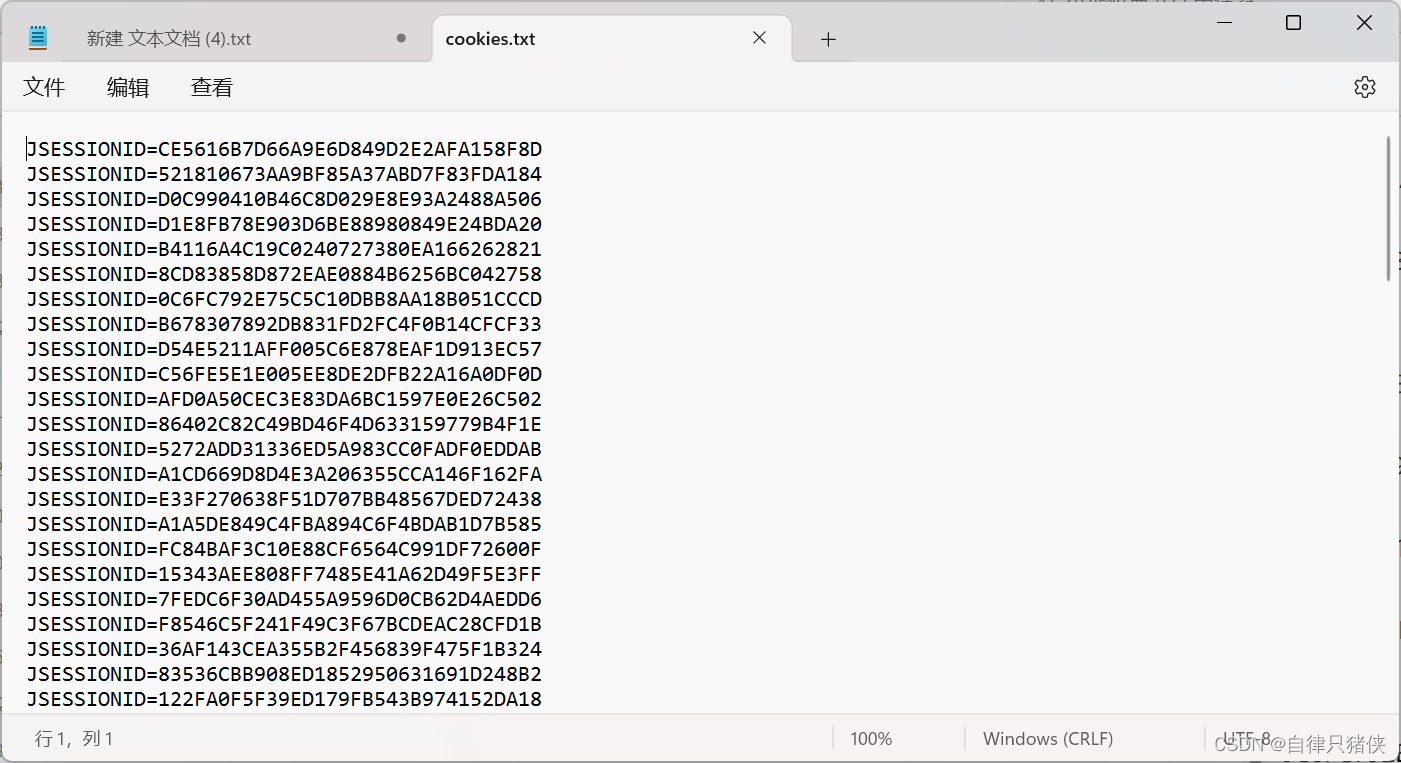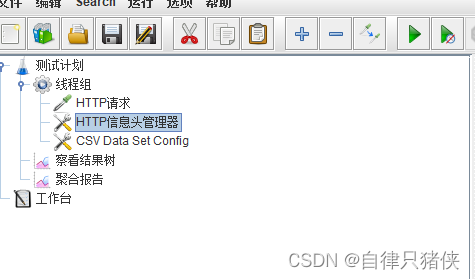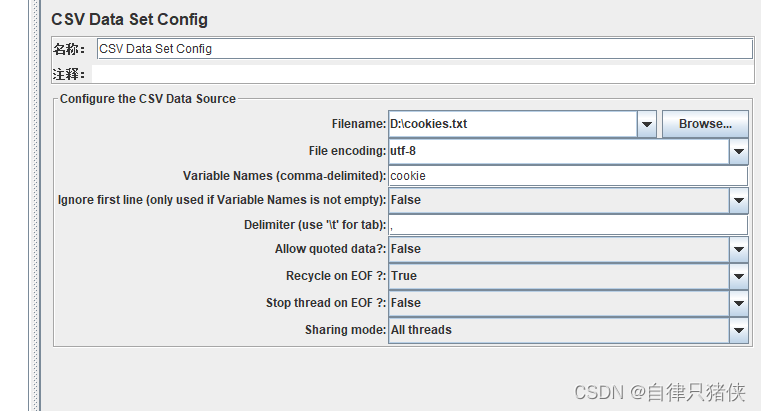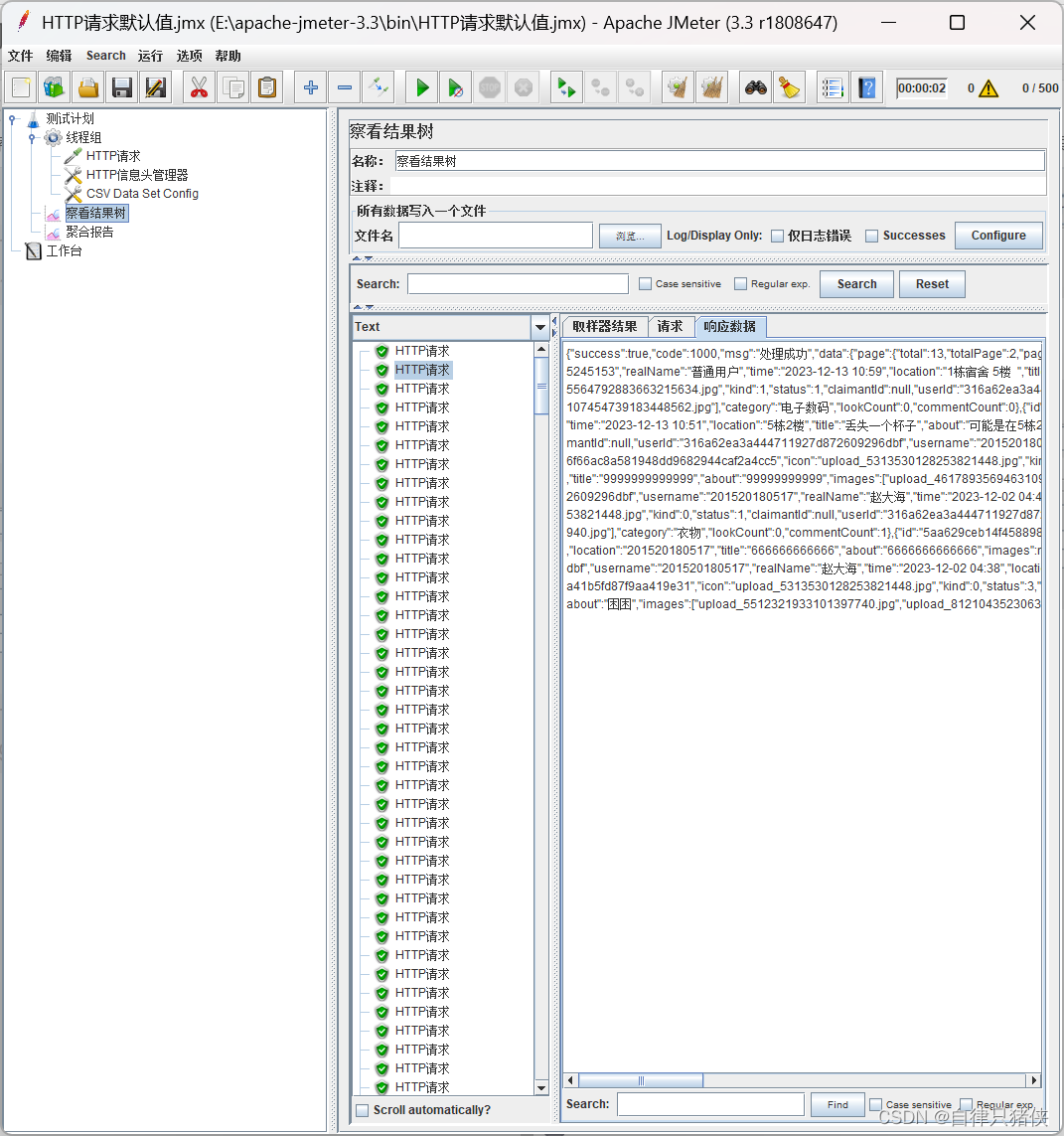Jmeter如何测试需要登录的接口
发布时间:2023年12月23日
首先说明本系统的登录采用的是session,但是无论是什么登录步骤都是大差不差的
1.首先要构造用户测试的数据保存到数据库

2.构造请求获取请求后的请求头(如果需要代码参照请看最后)
3.解析请求头获取需要的cookie(sessionId是放在cookie中)或token。如果对header的结果无法把控就打印一个看一下结构再解析
4.保存所有的cookie或token到一个txt文件中

5.接下来就是jmter的测试环节,最基本得有这几个

选择刚刚生成的cookie.txt文件

使用${}获取即可

接下来测试即可

所有代码
/**
* 登录接口示例
*/
@PostMapping("/login")
@ResponseBody
public ResponseDTO userLogin(@Valid @RequestBody UserLoginReq req, HttpSession session, HttpServletRequest request)
@Test
public void testCreateUserGetCookie() throws IOException {
//1.创建测试用户集合信息,插入user表和student表
List<TUserEntity> userEntityList = new ArrayList<>();
List<TStudentEntity> studentEntityList = new ArrayList<>();
//2.保存用户信息
for (int i = 1; i <= 500; i++) {
UUID uuid = UUID.randomUUID();
String userId = uuid.toString().replaceAll("-", "");
//user表
TUserEntity userEntity = new TUserEntity();
userEntity.setId(userId);
userEntity.setRealName("user"+i);
userEntity.setGender(1);
userEntity.setUsername("123123"+i);
userEntity.setPhoneNumber("130"+String.format("%0" + (11 - "130".length()) + "d", i));
userEntity.setEmail("2080067852"+"@qq.com");
userEntity.setPassword( CommonUtils.encodeByMd5(defaultPassword+salt));
userEntity.setSchoolId("001");
userEntity.setCampusId("0011");
userEntity.setIcon("school.png");
userEntity.setStatus(1);
userEntity.setRecordStatus(1);
userEntity.setKind(0);
userEntity.setCreateTime(new Date());
userEntityList.add(userEntity);
//student表
TStudentEntity tStudentEntity = new TStudentEntity();
tStudentEntity.setSchoolId("001");
tStudentEntity.setUserId(userId);
tStudentEntity.setStudentNum("2015201805"+i);
tStudentEntity.setName("张"+i+"憨");
tStudentEntity.setGender(1);
tStudentEntity.setCampus("test");
tStudentEntity.setMajor("test");
tStudentEntity.setClassNum("311631");
tStudentEntity.setCreateTime(new Date());
studentEntityList.add(tStudentEntity);
}
//3.批量保存
studentService.saveBatch(studentEntityList);
userService.saveBatch(userEntityList);
//4.批量发起请求
for (int i = 0; i < userEntityList.size(); i++) {
//拼装参数发起请求,根据你自己的登录接口
UserLoginReq userLoginReq = new UserLoginReq();
userLoginReq.setUsername("123123"+(i+1));
userLoginReq.setPassword("123456");
userLoginReq.setSchoolId("001");
userLoginReq.setCode("da513");
String url="http://localhost:8080/api/v1/public/login";
//发起请求,保存tokenn.txt文件
sendHttpGetCookie(userLoginReq, url);
}
}
private void sendHttpGetCookie(UserLoginReq userLoginReq, String url) throws IOException {
// 2.创建Httpclient对象
CloseableHttpClient httpClient = HttpClients.createDefault();
// 创建Http Post请求
HttpPost httpPost = new HttpPost(url);
httpPost.setHeader("Content-Type", "application/json;charset=UTF-8");
//3.封装需要的数据
String json = JSON.toJSONString(userLoginReq); // 将对象转换为 JSON 字符串
StringEntity requestEntity = new StringEntity(json, StandardCharsets.UTF_8);
httpPost.setEntity(requestEntity);
// response = httpClient.execute(httpPost);
//4.解析结果
CloseableHttpResponse execute = httpClient.execute(httpPost);
Header[] headers = execute.getAllHeaders();
for (Header header : headers) {
System.out.println(header.getName()+":"+header.getValue());
}
String value = headers[3].getValue();
String cookie = value.split(";")[0];
//2.写入文件
File filePath=new File("D:/cookies.txt");
FileWriter fileWriter = new FileWriter(filePath, true); // 使用 true 表示追加写入
BufferedWriter bufferedWriter = new BufferedWriter(fileWriter);
bufferedWriter.write(cookie);
bufferedWriter.newLine(); // 换行
// 关闭文件写入流
bufferedWriter.close();
System.out.println("cookieRes: "+cookie);
}
<dependency>
<groupId>org.apache.httpcomponents</groupId>
<artifactId>httpclient</artifactId>
<version>4.5.13</version>
<scope>compile</scope>
</dependency>
<dependency>
<groupId>org.apache.httpcomponents</groupId>
<artifactId>httpmime</artifactId>
<version>4.5.13</version>
<scope>runtime</scope>
</dependency>
文章来源:https://blog.csdn.net/qq_56533553/article/details/135141673
本文来自互联网用户投稿,该文观点仅代表作者本人,不代表本站立场。本站仅提供信息存储空间服务,不拥有所有权,不承担相关法律责任。 如若内容造成侵权/违法违规/事实不符,请联系我的编程经验分享网邮箱:chenni525@qq.com进行投诉反馈,一经查实,立即删除!
本文来自互联网用户投稿,该文观点仅代表作者本人,不代表本站立场。本站仅提供信息存储空间服务,不拥有所有权,不承担相关法律责任。 如若内容造成侵权/违法违规/事实不符,请联系我的编程经验分享网邮箱:chenni525@qq.com进行投诉反馈,一经查实,立即删除!
最新文章
- Python教程
- 深入理解 MySQL 中的 HAVING 关键字和聚合函数
- Qt之QChar编码(1)
- MyBatis入门基础篇
- 用Python脚本实现FFmpeg批量转换
- Hotspot源码解析-第二十章-系统类及其方法以符号形式存储在符号表(三)
- 硫磺,到2026年将以 3.9% 的复合年增长率增长
- 基于SpringBoot实现的前后端分离书店项目,功能:注册登录、浏览商品、热门商品、购物车、购买、地址管理、密码管理等
- 输出逆序数、求本利和和解一元二次方程(附带实例)
- 开始学习Vue(路由)
- WPS复选框里打对号,显示小太阳或粗黑圆圈的问题解决方法
- C语言代码 字母大小写转换
- 低代码核心能力详解:简化应用开发的新思路
- 二维码地址门牌管理系统:预约安全、智能生活
- 有相关so文件,apache还是提示异常